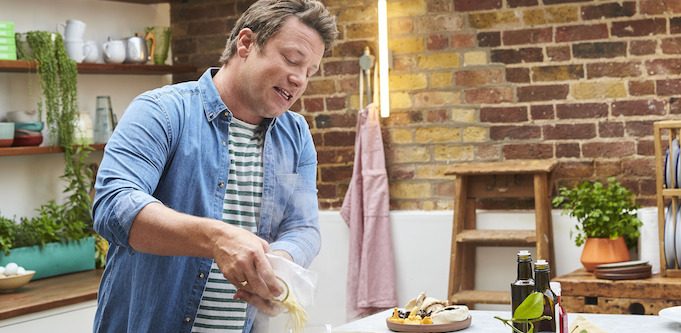
Jamie Oliver. Source: AAP.
The restaurant empires of celebrity chef’s George Calombaris and Heston Blumenthal have fallen over in Australia, and it’s not the first time prominent foodies have hit struggle street Down Under.
Calombaris, who is still dealing with the fallout from a multi-million dollar wage theft scandal, has shuttered his 12 Melbourne restaurants, while Blumenthal, who jumped into bed with Crown to launch Dinner with Heston in Melbourne, has pulled the plug after becoming embroiled in his own underpayment case, as reported by the SMH and The Age.
SmartCompany thought it worth revisiting this 2018 article, posing the question: why do celebrity chefs have so much trouble in Australia?
—
You’d be hard pressed to find anyone with a bad word to say about Jamie Oliver. The British TV darling who brought market-fresh meals to the tables of everymen everywhere, retains a personal brand as warm and inviting as his flaming rum’n’raisin. And yet, it seems no amount of fuzzy public sentiment could stop the collapse of his Australian chain of restaurants, Jamie’s Italian. Only four Australian franchises remain after an 11th-hour takeover, while Oliver’s global operations continue to struggle to refinance up to $125 million in debt.
Macaron master and MasterChef regular Adriano Zumbo has now suffered a similar fate. His three-company empire was this week put into voluntary administration, owing a reported debt of up to $10 million. Administrators were quick to assure customers his swathe of boutique sweet stores will stay open, but questions remain over their long-term viability.
If celebrity chefs can’t make these businesses work, what chance does anyone else have? And what’s making these cooking rock stars crumble in the heat of the off-set kitchen?
Dr Brent Coker, consumer psychologist at the University of Melbourne, says Australia is a complex market, where celebrities often overestimate the impact of their brand.
“When consumers make a decision about restaurants or cafes to eat at, there’s a few things that go through their mind,” Coker tells Crikey.
“They’ll consider location, price, availability, ambience, taste, and they’ll often associate these celebrity brands with quality and taste. The problem is that Australia’s already well-known for having really good quality food. So that mutes the impact of the brand on the decision.”
Coker says there can also be negative associations with these brands, such as price.
“This impacts on loyalty. We might go to Jamie Oliver’s restaurant to check it out and try it, but won’t necessarily go there every Thursday. Once we realise it’s equally as good at our cheaper local restaurant, we won’t go back.”
It’s not the first time international brands have misread Australian tastes.
“Remember when Starbucks closed down for example. They propagated everywhere in the world, there was a Starbucks on every corner. Melbourne was unusual in that once they’d set up shop, they disappeared overnight.
“These celebrity restaurants work better in the US because the quality of the food over there is not as good, and that’s probably what these celebrity chain restaurants ran into. It’s a fickle market here and when you’ve only got your brand to compete on, if that fails, what else have you got?”
Ken Burgin, community manager at industry provider Silver Chef and host of the podcast Profitable Hospitality,says the costs in the Australian hospitality market can also be prohibitive.
“There’s two special challenges for hospitality businesses in Australia,” he tells Crikey.
“Traditionally it’s very high rent — whether that’s a shopping centre like where Zumbo would have been trading or a main street in the case of Jamie’s Italian. The second is our very high wages. It’s ironic because people who work in hospitality are some of the lowest paid in Australia, it’s not like they’re taking home a lot of money. But the business model of restaurants in say Europe, pay much lower wage rates.
“A lot of businesses are very small and don’t have economies of scale. It would be very labour intensive for Jamie’s Italian to produce their product.”
Bankwest’s 2018 Future of Business: Future of Hospitality report also found Australians are increasingly “overlooking premium restaurants for mid-tier options and avoiding high margin items such as entrees, desserts and beverages”.
Burgin agrees that the most profitable operations don’t market solely on quality.
“The ones that are most successful are what we call quick-service restaurants, where you order at the counter, take a number and sit down, basically, reducing the labour costs. In the kitchen, it would also be a version of heat and serve, so a lot of that traditional skill is taken out of the kitchen and they can produce a high volume.”
He says startup costs can easily rack up massive debts, something MasterChef 2019 hopefuls would do well to remember.
“For Zumbo to set up one of his little stores it might be half a million dollars. You can buy a house for that.”
This article was first published by Crikey and featured on SmartCompany on August 6, 2018.
NOW READ: “I had two hours”: When Jamie Oliver discovered his restaurant empire was falling apart


COMMENTS
SmartCompany is committed to hosting lively discussions. Help us keep the conversation useful, interesting and welcoming. We aim to publish comments quickly in the interest of promoting robust conversation, but we’re a small team and we deploy filters to protect against legal risk. Occasionally your comment may be held up while it is being reviewed, but we’re working as fast as we can to keep the conversation rolling.
The SmartCompany comment section is members-only content. Please subscribe to leave a comment.
The SmartCompany comment section is members-only content. Please login to leave a comment.